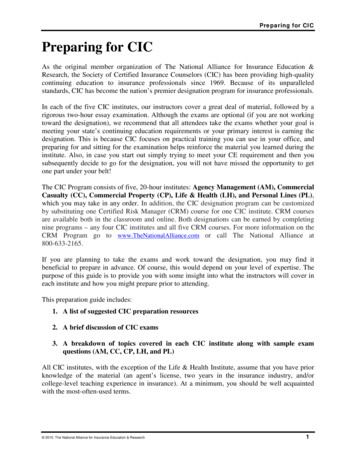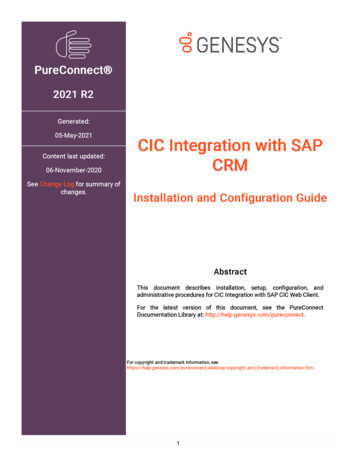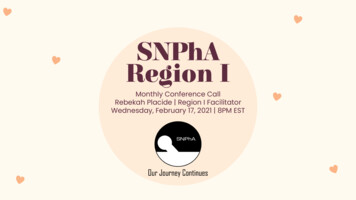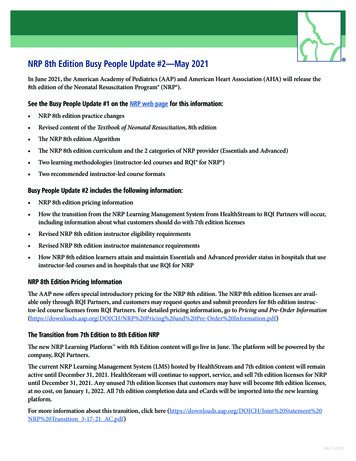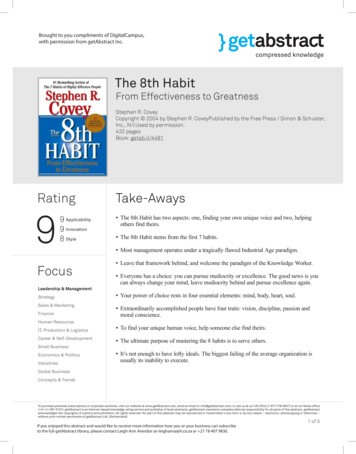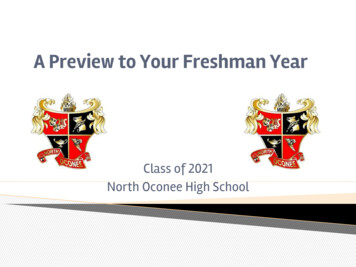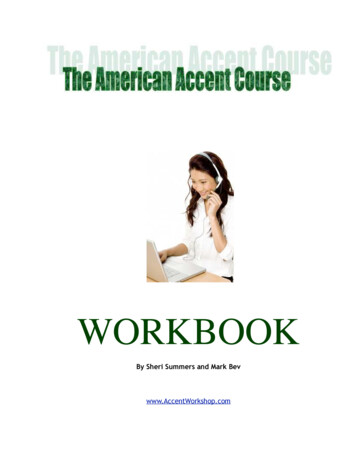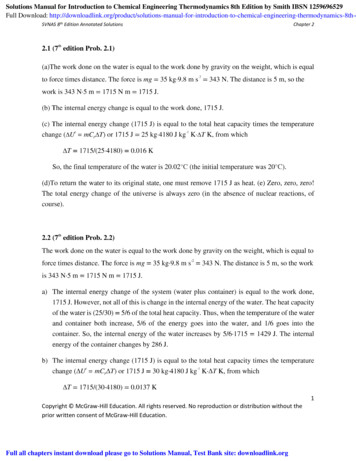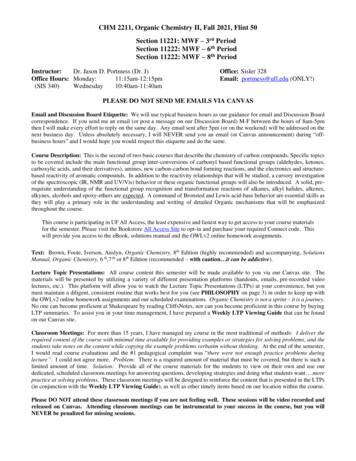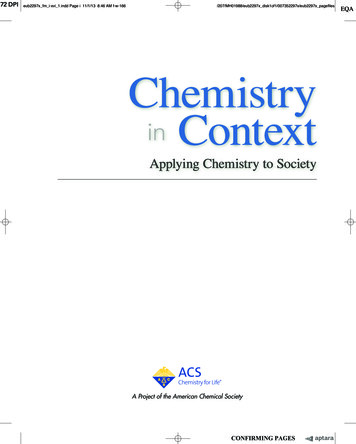
Transcription
eub2297x fm i-xvi 1.indd Page i 11/1/13 8:46 AM f-w-166/207/MH01988/eub2297x disk1of1/007352297x/eub2297x pagefiles A Project of the American Chemical Society
eub2297x fm i-xvi 1.indd Page ii 11/1/13 8:46 AM f-w-166/207/MH01988/eub2297x disk1of1/007352297x/eub2297x pagefiles
eub2297x fm i-xvi 1.indd Page iii 13/11/13 9:24 AM f-w-512/207/MH01988/eub2297x disk1of1/007352297x/eub2297x pagefilesEighth EditionCatherine H. MiddlecampUniversity of Wisconsin—MadisonMichael T. MuryAmerican Chemical SocietyKaren L. AndersonMadison CollegeAnne K. BentleyLewis & Clark CollegeMichael C. CannUniversity of ScrantonJamie P. EllisThe Scripps Research InstituteKathleen L. Purvis-RobertsClaremont McKenna,Pitzer, and Scripps Colleges A Project of the American Chemical Society
eub2297x fm i-xvi 1.indd Page iv 13/11/13 9:24 AM f-w-512/207/MH01988/eub2297x disk1of1/007352297x/eub2297x pagefilesCHEMISTRY IN CONTEXT: APPLYING CHEMISTRY TO SOCIETY, EIGHTH EDITIONPublished by McGraw-Hill Education, 2 Penn Plaza, New York, NY 10121. Copyright 2015 byMcGraw-Hill Education. All rights reserved. Printed in the United States of America. Previouseditions 2012, 2009, and 2006. No part of this publication may be reproduced or distributed in anyform or by any means, or stored in a database or retrieval system, without the prior written consent ofMcGraw-Hill Education, including, but not limited to, in any network or other electronic storage ortransmission, or broadcast for distance learning.Some ancillaries, including electronic and print components, may not be available to customersoutside the United States.This book is printed on acid-free paper.1 2 3 4 5 6 7 8 9 0 DOW/DOW 1 0 9 8 7 6 5 4ISBN 978–0–07–352297–5MHID 0–07–352297–XSenior Vice President, Products & Markets: Kurt L. StrandVice President, General Manager, Products & Markets: Marty LangeVice President, Content Production & Technology Services: Kimberly Meriwether DavidManaging Director: Thomas TimpExecutive Brand Manager: David Spurgeon, Ph.D.Director of Development: Rose KoosDevelopment Editor: Jodi RhombergMarketing Manager: Heather WagnerDirector, Content Production: Terri SchieslContent Project Manager: Sandra M. SchneeBuyer: Nichole BirkenholzDesigner: Tara McDermottCover Image: Lou Paintin/Getty Images/RFLead Content Licensing Specialist: Carrie K. BurgerCompositor: Aptara , Inc.Typeface: 10/12 Times LTPrinter: R. R. DonnelleyAll credits appearing on this page or at the end of the book are considered to be an extension of thecopyright page.Library of Congress Cataloging-in-Publication DataMiddlecamp, Catherine.Chemistry in context : applying chemistry to society. – Eighth edition.pages cm“American Chemical Society.”“Prepared by a team of writers: Cathy Middlecamp [and five others]”–Title page verso.Includes index.ISBN 978–0–07–352297–5 — ISBN 0–07–352297–X (hard copy : acid-free paper)1. Biochemistry. 2. Environmental chemistry. 3. Geochemistry. I. American Chemical Society. II. Title.QD415.C482 2015540–dc232013033969The Internet addresses listed in the text were accurate at the time of publication. The inclusion of awebsite does not indicate an endorsement by the authors or McGraw-Hill Education, and McGrawHill Education does not guarantee the accuracy of the information presented at these sites.www.mhhe.com
eub2297x fm i-xvi 1.indd Page v 11/1/13 8:47 AM f-w-166/207/MH01988/eub2297x disk1of1/007352297x/eub2297x pagefilesBrief Contents0 Chemistry for a Sustainable Future21 The Air We Breathe162 Protecting the Ozone Layer643 The Chemistry of Global Climate Change1064 Energy from Combustion1545 Water for Life2026 Neutralizing the Threats of Acid Rain and Ocean Acidification 2467 The Fires of Nuclear Fission2868 Energy from Electron Transfer3349 The World of Polymers and Plastics37210 Manipulating Molecules and Designing Drugs41011 Nutrition: Food for Thought45012 Genetic Engineering and the Molecules of Life494Appendices1 Measure for Measure: Metric Prefixes, Conversion Factors,and ConstantsA-12 The Power of ExponentsA-23 Clearing the LogjamA-34 Answers to Your Turn Questions Not Answered in the TextA-45 Answers to Selected End-of-Chapter Questions Indicatedin Color in the TextA-16GlossaryG-1CreditsC-1IndexI-1v
eub2297x fm i-xvi 1.indd Page vi 11/1/13 8:47 AM f-w-166/207/MH01988/eub2297x disk1of1/007352297x/eub2297x pagefiles
eub2297x fm i-xvi 1.indd Page vii 11/1/13 8:47 AM f-w-166/207/MH01988/eub2297x disk1of1/007352297x/eub2297x pagefilesContentsPrefacexiProtecting the Ozone LayerChapter 0Chemistry for a SustainableFuture20.1The Choices We Make Today0.2The Sustainable PracticesWe Need for Tomorrow50.3The Triple Bottom Line70.4Cradle–to–Where?80.5Your Ecological Footprint940.6 Our Responsibilities asCitizens and Chemists120.713Back to the Blue MarbleQuestions1.1What’s in a Breath?171.2What Else Is in a Breath?211.3Air Pollutants and Risk Assessment 231.4 Air Quality and You1.5291.6 Classifying Matter: PureSubstances, Elements, andCompounds301.7Atoms and Molecules331.8Names and Formulas:The Vocabulary of Chemistry35Chemical Change: The Role ofOxygen in Burning361.101.11Fire and Fuel: Air Quality andBurning HydrocarbonsAir Pollutants: Direct Sources42461.13 The Inside Story of Air Quality49Back to the Breath—at theMolecular LevelConclusionChapter SummaryQuestions2.2Atomic Structure and Periodicity682.3Molecules and Models712.4 Waves of Light752.5 Radiation and Matter782.6The Oxygen–Ozone Screen802.7Biological Effects of UltravioletRadiation822.8Stratospheric Ozone Destruction:Global Observations andCauses852.9Chlorofluorocarbons: Properties,Uses, and Interactions withOzone88The Antarctic Ozone Hole:A Closer Look922.11Responses to a Global Concern942.12Replacements for CFCsand Halons962.13Replacements for theReplacements98ConclusionChapter SummaryQuestions53565757101101102Chapter 3The Chemistry of GlobalClimate Change1063.1In the Greenhouse:Earth’s Energy Balance1083.2Gathering Evidence:The Testimony of Time1113.3Molecules:How They Shape Up116Vibrating Molecules and theGreenhouse Effect121The Carbon Cycle124391.12 Ozone: A Secondary Pollutant1.146526Where We Live: TheTroposphere1.9Ozone: What and Where Is It?2.1016642.114Chapter 1The Air We BreatheChapter 23.43.53.6 Quantitative Concepts: Mass1263.7 Quantitative Concepts:Molecules and Moles1283.8Methane and OtherGreenhouse Gases1303.9How Warm Will thePlanet Get?133vii
eub2297x fm i-xvi 1.indd Page viii 11/1/13 8:47 AM f-w-166viii/207/MH01988/eub2297x disk1of1/007352297x/eub2297x pagefilesContents3.10 The Consequences ofClimate Change1383.11 What Can (or Should) WeDo About Climate Change?142ConclusionChapter SummaryQuestions148148149Chapter 4Energy from Combustion4.1Fossil Fuels and Electricity1541564.2 Efficiency of EnergyTransformation1594.3The Chemistry of Coal1614.4Petroleum and Natural Gas1664.5 Measuring Energy Changes1714.6Chapter 6Neutralizing the Threats of AcidRain and Ocean Acidification 2466.1What Is an Acid?2486.2What Is a Base?2496.3Neutralization: Bases AreAntacids2516.4Introducing pH2536.5Ocean Acidification2546.6The Challenges of Measuringthe pH of Rain2566.7 Sulfur Dioxide and theCombustion of Coal6.86.9261Nitrogen Oxides and theCombustion of Gasoline263The Nitrogen Cycle2646.10SO2 and NOx—How DoThey Stack Up?2686.11Acid Deposition and ItsEffects on Materials270Energy Changes at theMolecular Level1754.7The Chemistry of Gasoline1784.8New Uses for an Old Fuel181Biofuels I—Ethanol183Biofuels II—Biodiesel1876.12 Acid Deposition, Haze, andHuman Health2744.11 Biofuels and the Way Forward1916.13278ConclusionChapter SummaryQuestions195196196ConclusionChapter SummaryQuestions4.94.10280280281Chapter 7Chapter 5Water for LifeDamage to Lakes and Streams202The Fires of Nuclear Fission2865.1The Unique Properties of Water2047.15.2The Role of Hydrogen Bonding2067.2How Fission Produces Energy2907.3How Nuclear ReactorsProduce Electricity296What Is Radioactivity?2995.3The Water We Drink and Use2085.4Water Issues2125.5 Aqueous Solutions2162195.6A Closer Look at Solutes5.7Names and Formulas of IonicCompounds5.8The Ocean—An AqueousSolution with Many Ions225Covalent Compounds andTheir Solutions2275.95.10Protecting Our Drinking Water:Federal Legislation5.11 Water Treatment5.12Water Solutions for GlobalChallengesConclusionChapter SummaryQuestions2227.4Nuclear Power Worldwide2887.5 Looking Backward to GoForward3027.6Nuclear Radiation and You3067.7The Weapons Connection3127.8Nuclear Time: The Half–Life3157.9Nuclear Waste: Here Today,Here Tomorrow3197.10230Risks and Benefits ofNuclear Power3232347.11 A Future for Nuclear Power325237241241242ConclusionChapter SummaryQuestions328328329
eub2297x fm i-xvi 1.indd Page ix 13/11/13 9:24 AM f-w-512/207/MH01988/eub2297x disk1of1/007352297x/eub2297x pagefilesContentsChapter 8Energy from Electron Transfer8.18.2334Batteries, Galvanic Cells, andElectrons336Other Common Galvanic Cells3398.3 Battery Ingredients:Cradle–to–Cradle3428.4Hybrid Vehicles3458.5Fuel Cells: The Basics3488.6Hydrogen for Fuel Cell Vehicles3528.7Photovoltaic Cells: The Basics3568.8Electricity from Renewable(Sustainable) SourcesConclusionChapter SummaryQuestions9.1Polymers Here, There, andEverywhere43710.10 Drugs of Abuse440ConclusionChapter SummaryQuestions444445445Chapter 11Nutrition: Food for Thought45011.1 Food and the Planet452You Are What You Eat45436411.3Fats and Oils45636636736711.4Fats, Oils, and Your Diet4603723739.2 Polymers: Long, Long Chains3749.3Adding Up the Monomers3759.4Polyethylene: A Closer Look3779.5The “Big Six”: Theme andVariations3819.6Condensing the Monomers3859.7Polyamides: Natural and Nylon 3899.8 Dealing with Our Solid Waste:The Four Rs10.9 Herbal Medicine43411.2Chapter 9The World of Polymersand Plastics10.8 Prescription, Generic, andOver–the–Counter Medicines11.5 Carbohydrates: Sweetand Starchy46511.6How Sweet It Is: Sugars andSugar Substitutes46711.7Proteins: First Among Equals47011.8 Vitamins and Minerals:The Other Essentials47311.9 Energy from Food47711.10 Dietary Advice: Quality VersusQuantity48111.11 From Field to Fork48311.12 Feeding a Hungry World486ConclusionChapter SummaryQuestions489489490391Chapter 12395Genetic Engineering and theMolecules of Life9.10From Plants to Plastics40012.19.11Shifting Baselines401Stronger and BetterCorn Plants?49512.2A Chemical That Codes Life4979.9 Recycling Plastics: The BiggerPictureConclusionChapter SummaryQuestions404405405Chapter 10Manipulating Molecules andDesigning Drugs41010.1 A Classic Wonder Drug41110.2 The Study of Carbon–Containing Molecules41310.3 Functional Groups41710.4 How Aspirin Works:Function Follows Form42110.5 Modern Drug Design42410.6 Give These Molecules a Hand!42810.7 Steroids43249412.3 The Double Helix of DNA50112.4Cracking the Chemical Code50612.5Proteins: Form to Function50712.6The Process of GeneticEngineering511Making Chemical SynthesisGreen from Genetic Engineering515The New Frankenstein51712.712.8ConclusionChapter SummaryQuestions519520520ix
eub2297x fm i-xvi 1.indd Page x 11/1/13 8:47 AM f-w-166x/207/MH01988/eub2297x disk1of1/007352297x/eub2297x pagefilesContentsAppendix 1Appendix 4Measure for Measure: MetricPrefixes, Conversion Factors,and ConstantsAnswers to Your Turn QuestionsNot Answered in the TextA-4A-1Appendix 5Appendix 2The Power of ExponentsA-2Answers to Selected End-of-ChapterQuestions Indicated in Colorin the TextA-16A-3GlossaryCreditsIndexAppendix 3Clearing the LogjamG-1C-1I-1
eub2297x fm i-xvi 1.indd Page xi 13/11/13 9:34 AM f-w-512/207/MH01988/eub2297x disk1of1/007352297x/eub2297x pagefilesPrefaceDear Readers,The word context appears in the title of this book. And context has multiple meanings.Context! Did you know that the word derives from the Latin word meaning “toweave”? The spiderweb image on the cover conveys the connections that this bookweaves between chemistry and society. In the absence of societal issues, there could beno Chemistry in Context. Similarly, without teachers and students who were willing (andbrave enough) to engage in these issues, there could be no Chemistry in Context. Chemistry is woven into the fabric of practically every issue that our society faces today.Context! Do you enjoy good stories about the world in which you live? If so,look inside this book for stories that intrigue, challenge, and possibly even motivate youto act in new or different ways. In almost all contexts—local, regional, and global—partsof these stories are still unfolding. The ways in which you and others make choicestoday will determine the nature of the stories told in the future.Context! Are you aware that using a real-world context to engage people is a highimpact practice backed by the research on how people learn? Chemistry in Context offersreal-world contexts through which to engage learners on multiple levels: personal, societal,and global. Given the rapidly changing nature of these contexts, Chemistry in Context alsooffers teachers the opportunity to become learners right along with their students.Sustainability—The Ultimate ContextGlobal sustainability is not just a challenge. Rather, it is the defining challenge of ourcentury. Accordingly, the eighth edition of Chemistry in Context is designed to helpstudents meet this challenge. The opening chapter, “Chemistry for a SustainableFuture,” sets the stage for the 12 chapters that follow. By placing sustainability first,sustainability is established as a core, normative part of the chemistry curriculum.Sustainability adds a new degree of complexity to Chemistry in Context. Thiscomplexity arises in part because sustainability can be conceptualized in two ways: asa topic worth studying and as a problem worth solving. As a topic, sustainability provides a new body of content for students to master. For example, the tragedy of thecommons, the Triple Bottom Line, and the concept of cradle-to-cradle all are part ofthis new body of content. As a problem worth solving, sustainability generates newquestions for students to ask—ones that help them to imagine and achieve a sustainablefuture. For example, students will find questions about the risks and benefits of acting(or not acting) to reduce emissions of greenhouse gases.Incorporating sustainability requires more than a casual rethinking of the curriculum. Which approach do the authors take? Unlike most general chemistry texts, this oneis context rich. Thus, the writers already had the necessary vehicle through which toconvey the concepts of sustainability—rich real-world scenarios about energy, food, andwater. However, the connections to sustainability were not always readily apparent. Inessence, the dots needed to be connected for the reader. Here are some examples of howthis was done:Chapter 1, “The Air We Breathe,” now more strongly reminds the reader that the air isa resource held in common. We all must breathe it, and nobody owns it. Air pollution isthus a perfect means by which to introduce the concept of the tragedy of the commons.Chapter 2, “Protecting the Ozone Layer,” now more clearly points out that the olderreplacements for chlorofluorocarbons (CFCs), although not harmful to the ozone layer,are potent greenhouse gases. The chapter ends with a decisive call to action: “We all,The tragedy of the commons is thesituation in which a resource is commonto all and used by many, but has no onein particular responsible for it. As a result,the resource may be destroyed byoveruse to the detriment of all that use it.xi
eub2297x fm i-xvi 1.indd Page xii 11/1/13 8:47 AM f-w-166xii/207/MH01988/eub2297x disk1of1/007352297x/eub2297x pagefilesPrefacebreathing on this planet today and having the potential, must guarantee its future,rapidly and decisively. We have no right to delay; we have no luxury of losing time.”Chapter 3, “The Chemistry of Global Climate Change,” now presents more data on thechemistry of global climate change, and challenges students to evaluate the changesoccurring on Earth from greenhouse gases and the consequences of these changes.Chapter 5, “Water for Life,” now better connects the scarcity of fresh water, sustainablemanagement of water resources, and water contamination. These themes are echoed indiscussing food production in Chapter 11.Chapter 7, “The Fires of Nuclear Fission,” while introducing students to the nuclearcrisis that occurred in Japan, also challenges students to evaluate nuclear power as asustainable resource.Chapter 8, “Energy from Electron Transfer,” was recast to better show the matchbetween our energy needs and the available technologies. The sustainability conceptof cradle-to-cradle, introduced in Chapter 0, is connected to battery design.Chapter 11, “Nutrition: Food for Thought,” still describes how what you eat affectsyour health. Now, however, it more strongly connects what you eat to the health of theplanet and has students track food production and consumption.Green chemistry, a means to sustainability, continues to be an important themein Chemistry in Context. As in previous editions, examples of green chemistry arehighlighted in each chapter. In this new edition, look for more examples. This expandedcoverage offers the reader an even better sense of the need for and the importance ofgreening our chemical processes. For easier access, key ideas in green chemistry arelisted on the inside front cover of the text.Updates to Existing ContentPeople sometimes ask us, “Why do you release new editions so often?” Indeed, we areon a fast publishing cycle, turning out a new version every three years. We do thisbecause the content in Chemistry in Context is time sensitive.With each new edition, the author team reworks the content of practically everychapter, updating it to reflect new scientific developments, changes in policies, energytrends, and current world events. These updates are nontrivial to implement. Some involvewriting new content; others involve producing new graphs and data tables. For example,since the publication of the 7th edition, the tragedy in Fukushima, Japan, has influencednuclear power industries and policies. The atmospheric concentration of CO2 increasedto over 400 ppm. A final example is the release of new dietary guidelines from the USDA.In addition, the issues that we select to “hook” the reader at the start of thechapter are recast from edition to edition. Chapter 9, “The World of Polymers andPlastics,” is one example. The new version now opens with a quote from the bookcoauthored by a chemist who greatly influenced our thinking in revising this chapter:“Nature doesn’t have a design problem. People do.” (William McDonough and MichaelBraungart, Cradle-to-Cradle, 2002)The story of polymers unfolds using a spiderweb as an example, noting that orbspiders may build new webs each day. So how does an orb spider manage to spin somuch silk and still survive? Most simply, it recycles. Orb spiders have the ability toingest old spider silk and recover the raw materials from which they are constructed.The theme of recycling is then carried throughout the chapter.Teaching and Learning in ContextThis new edition of Chemistry in Context continues with the organizational scheme usedin previous editions, one that has stood the test of time. The first six chapters, all withreal-world themes such as air, water, and energy, provide a foundation of chemistryconcepts on which to build in subsequent chapters. For example, early chapters introduceelements, compounds, and the periodic table. In later chapters, we build upon these
eub2297x fm i-xvi 1.indd Page xiii 11/1/13 8:47 AM f-w-166/207/MH01988/eub2297x disk1of1/007352297x/eub2297x pagefilesPrefacechemistry concepts to consider other contexts and chemistry content. Chapters 7 and 8consider additional energy sources—nuclear power, batteries, fuel cells, and hydrogen.Chapters 9–12 are all carbon based, focusing on polymers, drugs, food production, andgenetic engineering. They provide students with the opportunity to explore interests, astime permits, beyond the core topics.The New Edition—A Team EffortOnce again, we have the pleasure of offering our readers a new edition of Chemistryin Context. But the work is not done by just one individual; rather, it is the work ofmany talented individuals. The eighth edition builds on the legacy of prior author teamsled by A. Truman Schwartz, Conrad L. Stanitski, and Lucy Pryde Eubanks, all nowretired from long and successful careers of teaching chemistry.This new edition was prepared by a team of writers: Cathy Middlecamp,Michael Mury, Karen Anderson, Anne Bentley, Michael Cann, Jamie Ellis, and KatiePurvis-Roberts. The laboratory manual to accompany it was revised by Jennifer Trippand Lallie McKenzie and reviewed by Teresa Larson. Each person brought differentexpertise to the project. In common, though, each brought goodwill, hopes, dreams,and seemingly boundless enthusiasm to bring real-world chemistry into the classroomand into the lives of our readers.At the American Chemical Society, leadership was provided by Mary Kirchhoff,Director of the Education Division. She supported the writing team, cheering on itsefforts to “connect the dots” between chemistry and sustainability, even to the point ofwriting parts of Chapter 0. Furthermore, she and Terri Taylor, Assistant Director forK–12 Science at the American Chemical Society, made it possible for Michael Muryto expand his role in the project, taking the reins as a production manager. His abilitiesto bring together all of the parties involved—the author team, the publisher, and theAmerican Chemical Society—were unparalleled.The McGraw-Hill team was superb in all aspects of this project, with specialthanks to Jodi Rhomberg for shepherding the project to the finish line. Marty Lange(Vice President and General Manager), Thomas Timp (Managing Director), DavidSpurgeon, PhD (Brand Manager), Rose Koos (Director of Development), ShirleyHino, PhD (Director of Digital Content Development), and Jodi Rhomberg (Developmental Editor) led this outstanding team. Heather Wagner served as the ExecutiveMarketing Manager. Sandra Schnee (Content Project Manager) coordinated the production team of Carrie Burger (Content Licensing Specialist), Tara McDermott(Designer), and Nichole Birkenholz (Buyer). The team also benefited from the carefulediting of Carol Kromminga and proofreading by Kim Koetz and Patti Evers.The author team truly benefited from the expertise of a wider community. We wouldlike to thank the following individuals who wrote and/or reviewed learning-goal-orientedcontent for LearnSmart.Peter de Lijser, California State University—FullertonDavid G. Jones, University of North Carolina at Chapel HillAdam I. Keller, Columbus State Community CollegeWe also extend our thanks to David McNelis, University of North Carolina, for thetechnical expertise he provided in preparing the manuscript.Input from instructors teaching this course is invaluable to the development ofeach new edition. Our thanks and gratitude go out to the following instructors whoparticipated in Chemistry in Context workshops:Sana AhmedNikki BurnettDonghai ChenTammy CrosbyMohammed DaoudiSidnee-Marie DunnKimberly FieldsBoca Raton Community High SchoolBaldwin High SchoolMalone UniversityHillsborough High SchoolUniversity of Central FloridaSaint Martins UniversityFlorida Southern Collegexiii
eub2297x fm i-xvi 1.indd Page xiv 11/1/13 8:47 AM f-w-166xiv/207/MH01988/eub2297x disk1of1/007352297x/eub2297x pagefilesPrefaceTam’ra Kay FrancisAndrew FrazerSong GaoCarmen GauthierMyung HanAl HazariSandra HelquistMartha KellnerTodd KnippenbergCandace KristenssonShamsher-Patrick LambdaLaura LanniDevin LatimerToby LongSara MarchlewiczJessica MenkeMark Mitton-FryMark MorrisJung OhTatyana PinayayevKresimir RupnikIndrani SindhuvalliJose VitesUniversity of TennesseeUniversity of Central FloridaNova Southeastern UniversityFlorida Southern CollegeColumbus State Community CollegeUniversity of TennesseeLoyola University ChicagoWestminster CollegeHigh Point UniversityUniversity of DenverYoung Men’s Preparatory Academy (M-DCPS)Newberry CollegeUniversity of WinnipegRollins CollegeUniversity of Illinois at ChicagoUniversity of Wisconsin—WhitewaterOhio Wesleyan UniversityUniversity of TampaKansas State University at SalinaMiami UniversityLousiana State UniversityFlorida State College at JacksonvilleEastern Michigan UniversityWishing Our Readers WellWhen first published in 1993, Chemistry in Context was “the book that broke themold.” Unlike the books of its time, it did not teach chemistry in isolation from peopleand the real-world issues they were facing. Similarly, it did not introduce a fact orconcept for the sake of “covering it” as part of the curriculum. Rather, Chemistry inContext carefully matched each chemical principle to a real-world issue such as airquality, energy, or water use.We are very excited by the features of this new edition that continue to breakthe mold in bringing chemistry to you, our reader. We have selected engaging andtimely topics that we hope will serve you not only today but also in the years tocome.We wish you well as you read, explore the issues, respectfully argue with eachother (and with the authors), and, most important, as you use what you learn to bringyour dreams to reality.Sincerely, and with all good wishes from the author team,Cathy MiddlecampSenior Author and Editor–in–ChiefJune 2013
eub2297x fm i-xvi 1.indd Page xv 11/11/13 7:37 AM f-w-166/207/MH01988/eub2297x disk1of1/007352297x/eub2297x pagefilesPrefaceDigital ResourcesMcGraw-Hill offers various tools and technology products to support Chemistry inContext, 8th edition.McGraw-Hill’s ConnectPlus McGraw-Hill’s Connect Plus (www.mcgrawhillconnect.com/Chemistry) is a web-basedassignment and assessment platform that gives students the means to better connect withtheir coursework, with their instructors, and with the important conceptsthat they will need to know for successnow and in the future. The followingresources are available in Connect: Autograded assessmentsLearnSmart, an adaptive diagnostic toolPowerful reporting against learning outcomes and level of difficultyMcGraw-Hill Tegrity Campus, which digitally records and distributes yourlectures with a click of a buttonThe full textbook as an integrated, dynamic eBook that you can also assignInstructor resources, such as Instructor’s ManualPowerPoints and Test BanksImage Bank, which includes all images available for presentation tools.With ConnectPlus, instructors can deliver assignments, quizzes, and tests online.Instructors can edit existing questions and author entirely new problems; track individual student performance—by question and assignment or in relation to the classoverall—with detailed grade reports; integrate grade reports easily with LearningManagement Systems (LMS), such as WebCT and Blackboard; and much more.By choosing Connect, instructors are providing their students with a powerful toolfor improving academic performance and truly mastering course material. Connectallows students to practice important skills at their own pace and on their own schedule.Importantly, students’ assessment results and instructors’ feedback are all saved online,so students can continually review their progress and plot their course to success.McGraw-Hill LearnSmart McGraw-Hill LearnSmart is available as a stand-alone product as well as an integratedfeature of McGraw-Hill Connect Chemistry. It is an adaptive learning system designedto help students learn faster, study more efficiently, and retain more knowledge forgreater success. LearnSmart assesses a student’s knowledge of course content through aseries of adaptive questions. It pinpoints concepts the student does not understand andmaps out a personalized study plan for success. This innovative study tool also hasfeatures that allow instructors to see exactly what students have accomplished and abuilt-in assessment tool for graded assignments. Visit the following site for a demonstration: www.mhlearnsmart.com.McGraw-Hill SmartBook Powered by the intelligent and adaptive LearnSmart engine, SmartBook is the first andonly continuously adaptive reading experience available today. Distinguishing whatstudents know from what they don’t, and honing in on concepts they are most likelyto forget, SmartBook personalizes content for each student. Reading is no longer apassive and linear experience but an engaging and dynamic one, where students aremore likely to master and retain important concepts, coming to class better prepared.xv
eub2297x fm i-xvi 1.indd Page xvi 11/11/13 7:40 AM f-w-166xvi/207/MH01988/eub2297x disk1of1/007352297x/eub2297x pagefilesPrefaceSmartBook includes powerful reports that identify specific topics and learningobjectives students need to study. These valuable reports also provide instructors insightinto how students are progressing through textbook content and are useful for identifyingclass trends, focusing precious class time, providing personalized feedback to students,and tailoring assessment.How does SmartBook work?Each SmartBook contains four components: Preview, Read, Practice, and Recharge.Starting with an initial preview of each chapter and key learning objectives, studentsread the material and are guided to topics over which they need the most practice basedon their responses to a continuously adapting diagnostic. Read and Practice continueuntil SmartBook directs students to recharge important material they are most likelyto forget to ensure concept mastery and retention.Customizable Textbooks: Create Create what you’ve only imagined. Introducing McGraw-Hill Create—a new, self-servicewebsite that allows you to create custom coursematerials—print and eBooks—by drawingupon McGraw-Hill’s comprehensive, cross-disciplinary content. Add your own contentquickly and easily. Tap into other rights-secured third party sources as well. Then,arrange the content in a way that makes the most sense for your course. Even personalize your book with your course name
Chemistry in context : applying chemistry to society. – Eighth edition. pages cm “American Chemical Society.” “Prepared by a team of writers: Cathy Middlecamp [and fi ve others]”–Title page verso. Includes index. ISBN 978–0–07–352297–5 — ISBN 0–07–3
